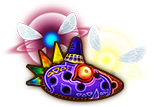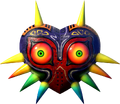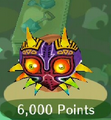- "The mask that was stolen from me... It is called Majora's Mask. It is an accursed item from legend that is said to have been used by an ancient tribe in its hexing rituals. It is said that an evil and wicked power is bestowed upon the one who wears that mask. According to legend... the troubles caused by Majora's Mask were so great... the ancient ones, fearing such catastrophe, sealed the mask in shadow forever, preventing its misuse..."
- — Happy Mask Salesman
Majora's Mask (ムジュラの仮面, Mujura no Kamen?) is a recurring item in the The Legend of Zelda series. It is a mask that is the major plot point of The Legend of Zelda: Majora's Mask.
Appearances[]
The Legend of Zelda: Majora's Mask[]
This ancient and powerful mask was once used in an ancient tribe's hexing rituals and was later sealed away because of its evil magic, which was so great that it might cause the destruction of the entire world. The mask was later recovered by the Happy Mask Salesman, a mysterious collector and seller of masks, who was eventually robbed of it by the mischievous Skull Kid. He then sought to use the mask's powers to draw the Moon out of orbit and destroy the entire land of Termina by causing an impact between the moon and the planet.
Abilities[]
The mask has the ability to bestow an evil and wicked power upon its wearer. It also seems to have a certain extent of autonomy: the game implies that it influenced the Skull Kid to steal it. The Salesman was worried it would do something terrible, even though he owned it. The mask is eventually able to cast off the Skull Kid and move on its own accord. With the evil power of the mask, the Skull Kid was granted various undefined abilities while wearing it. In the game, these include the ability to metamorphose the physical appearances of people, contaminate Termina's weather and vegetation, fly, curse certain areas that brought Poes and control the Moon. The only thing shown in Majora's Mask that has greater power than the mask itself is the Fierce Deity Mask, which Majora owned before giving it away. In the final battle between it and Link, the mask took on three forms, each having dark powers.
Story[]
Spoiler warning: Plot or ending details follow.
The Happy Mask Salesman, in fear that a great disaster could befall Termina, tells the story of Majora's Mask to Link, just after lifting the Deku Scrub curse placed on him by the Skull Kid. The mask is introduced as an accursed item from legend. It is said to have been used by a mysterious ancient tribe in its hexing rituals. The legend goes on to say that an evil and wicked power comes upon the one who wears the mask and that the troubles caused by it were so great that their folks sealed the mask in shadow forever, preventing a catastrophe and future misuse. The tribe eventually vanished too, and the true nature of the mask was no longer known.
Many years later, the Happy Mask Salesman, a strange collector of masks, went to 'great lengths' in a quest to find the legendary mask. When he uncovered it, he seemed to immediately regret it: he later claims that he could sense a 'dark omen brewing'. Because the Happy Mask Salesman never tries to implicate anyone else in the mask's release, it is assumed that the great lengths he went to to obtain it involved unsealing it from the shadow. Later, while traveling through the Lost Woods, the Happy Mask Salesman was knocked out and robbed of the mask by an imp known as the Skull Kid and his two fairy companions, Tatl and Tael. Although Tatl later acknowledges that the Skull Kid felt rejected because his friends had left him and nobody wanted to play with him, she claims this did not explain his attack. This indication that the Skull Kid was acting abnormally suggests the mask had some influence over the Skull Kid even while carried by the Mask Salesman. The Mask's use of its influence to escape the Happy Mask Salesman would indicate it was in some way restrained or unfulfilled under the Mask Salesman's ownership. Its success at escaping shows the lack of control the Mask Salesman had over the mask's activity after its retrieval.
The power residing within the mask took control of the Skull Kid and changed him from a mischievous child to a complete psychopath. The Skull Kid, now controlled by Majora's Mask, used the power of the mask to transform Link into a Deku Scrub after stealing both Link's mount, Epona, and the Ocarina of Time, while Link is travelling abroad. Majora, using its host to enforce its will, tore the Moon of Termina out of orbit and sent it on a collision course with Termina, with Clock Town being its main impact point. After terrorizing Link, the Skull Kid starts using his powers all over Termina for mischief, including transforming Kafei into a child, injuring Koume, threatening to steal the Moon's Tear from Shikashi's Astral Observatory, contaminating the water of the regions of Woodfall and Great Bay, creating a perpetual winter in Snowhead, fooling the Gerudo Pirates, and haunting Ikana with undead creatures by opening Stone Tower's doors. Other acts of vandalism have been attributed to the Skull Kid as well, but others are implied to have been involved in these.
However, Link stumbled upon the alternate reality during the chase with Skull Kid, and eventually manages to save the Moon from crashing into the world by calling the Four Giants, whom he had rescued through the course of the game. Its plan thwarted, Skull Kid is revealed to have been a mere puppet of Majora's Mask; Majora's Mask proceeds to enforce a will of its own, and detaches itself from its host body, fleeing to the interior of the Moon using a strand of energy. The moon, now possessed by Majora's Mask, begins to overpower the Four Giants, causing it to fall closer to Clock Town at a rapid speed. Link and Tatl pursue Majora using the same energy that Majora's Mask escaped with earlier, after hastily discussing what to do. Inside the Moon, Link finds four Lunar Children running around a big tree with a single child sitting alone at the base of the tree, all of which are wearing masks; four are wearing the Boss Remains that Link cleansed from the four Temples around Termina, while the fifth one wears Majora's Mask, seemingly harmless. Upon talking to the other Lunar Children, they ask about the weather, and proceed to ask Link for some of the various Masks he has collected throughout the game. Each time a child's tasks are clear, they will take Link to a trial. When Link speaks to the child wearing Majora's Mask, Link will be taken to the Final Boss room of the game to stand off against Majora's Mask. If Link has collected all of the game's masks and traded them to the children, the one wearing Majora's Mask will offer to play a game with Link and presents him with the Fierce Deity's Mask, the most powerful transformation mask. After the defeat of Majora's three forms, Majora's Mask, Majora's Incarnation and Majora's Wrath, the mask seemingly loses its power and sentience, burning in a colorful flame, as the moon disperses into a rainbow shooting across the sky of Termina; After Link, knocked out from the battle, reconciles with the Skull Kid, reminiscing on what had been happening for the past three days, the Happy Mask Salesman appears with Majora's Mask in his hands. After sharing his thoughts about how the evil in the mask has left, he takes it with him on his travels to places unknown, with a simple goodbye to Link, cryptically explaining to make more people happy.
The Legend of Zelda: Breath of the Wild[]
DLC warning: This article or section contains information that originates from DLC and might not be part of the Legend of Zelda series.
- "An eerie mask passed down from ancient times. Wearing it makes it harder for certain enemies to spot you. If sold, this rare find can't be replaced."
- — In-game description
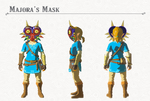
Promotional image of Link wearing Majora's Mask
In this game, the Majora's Mask is a head armor inspired by the mask from Majora's Mask. It has a defense base of 1 but allows Link to approach enemies such as Bokoblins, Moblins, Lizalfos and Lynels, without being attacked. As a result, it functions like a all-in-one version of the monster masks (Bokoblin Mask, Lizalfos Mask, Lynel Mask, and Moblin Mask) sold by Kilton at the Fang and Bone. However, like the Lynel Mask, it only affects Lynels temporarily before they realize Link's true identity.
According to the Adventure Log, the mask was one of the eight ancient treasures, initially collected as part of a historical collection, that ended up stolen from Hyrule Castle by the great thief Misko, though it is unclear if it is the original Majora's Mask or simply a replica. It is likely though, that there is likely no significant reason whatsoever for the mask's presence, other than being a reference.
Upon "The Master Trials" DLC pack installation and after the side quest "EX Treasure: Ancient Mask" is triggered, Link is guided to find and read the Misko's EX Journal at the Outpost Ruins, in order to discover the "Ancient Mask" treasure. Link can find a buried EX Treasure Chest containing the Majora's Mask at the ruins where soldiers gathered near where the waters of Lake Kolomo are visible which refers to the Kolomo Garrison Ruins. Link can find the chest buried just outside the largest building of the Kolomo Garrison Ruins which he can dig up using the Magnesis Rune.
DLC warning: DLC information ends here.
Reference[]

Majora's Mask hanging in Link's House
Majora's Mask makes a small cameo in The Legend of Zelda: A Link Between Worlds, where it can be seen hanging on the wall of Link's house. It is unknown it is the original Majora's Mask or not. Link can pass his head behind it, seeming wearing it, by using Ravio's Bracelet to merge with the wall it is hung on.
Spoiler warning: Spoilers end here.
Other appearances[]
Subseries warning: This article or section contains information on a subseries within the Legend of Zelda series and should be considered part of its own separate canon.
Hyrule Warriors[]
Majora's Mask appears in Hyrule Warriors in the Majora's Mask DLC during Young Link's Focus Spirit Finisher (worn by Skull Kid), as part of Lana's Skull Kid costume, and as part of Cia's costume from winning it in Adventure Mode.
In one mission after obtaining all of the Gold Skulltulas, Lana appears as the main enemy, seemingly having been taken over by the mask like the Skull Kid.
Majora's Mask also appears as one of the Item Cards found on the Termina Map in Adventure Mode. Using the Majora's Mask Item Card on the search screen will fill the Magic and SP gauges for one battle.
Using a download code that comes with Hyrule Warriors Legends, Skull Kid can be unlocked as a playable character in Hyrule Warriors. His Historical Entry Tutorial Bio and battle intro cutscene refers to Skull Kid with the title Majora's Puppet, indicating that he is controlling Skull Kid in Hyrule Warriors and Hyrule Warriors Legends.
Hyrule Warriors Legends[]
In Hyrule Warriors Legends, Skull Kid wearing Majora's Mask (and under its influence) appears as a playable character who uses an Ocarina as his weapon and can use it to command Tatl & Tael to attack enemies. There is also a weapon called Majora's Ocarina which is an Ocarina modeled after Majora's Mask itself and Skull Kid's Level 3 weapon in his Ocarina moveset.
In addition to Tatl, Tael, and his Puppets from Twilight Princess, Skull Kid can use the power of Majora's Mask during certain combos, allowing him to fire spheres of Dark energy, a fiery eye beam attack from Majora's Mask, and can also create Dark Magic Circle during his Special Attack. He also uses a mini-soccer ball sized Moon as part of his Focus Spirit attack.
Majora's Mask also appears as Skull Kid's Gold Material drop, marking the first time where it is a collectible item within a Zelda title (albeit a non-canon one). There is also a Fairy Clothing Headgear option for Companion Fairies based on Majora's Mask called the Trickster Mask which has a Darkness Elemental Attribute.
Subseries warning: Subseries information ends here.
Non-canonical appearances[]
Non-canon warning: This article or section contains non-canonical information that is not considered to be an official part of the Legend of Zelda series and should not be considered part of the overall storyline.
The Legend of Zelda: Majora's Mask manga[]
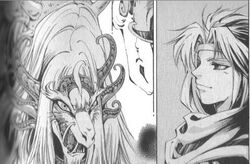
Majora from the Majora's Mask manga
The manga by Akira Himekawa, although not by official Nintendo authors, provides an original side story that attempts to explain the origin of the mask. In this story, Majora's Mask is revealed to have been made from the armor of a legendary beast named Majora, that lived around ten million years before the events of Majora's Mask. The land in which Majora lived was not moving, but not dead either, nor had it stopped. According to a myth devised "by the humans themselves," the armor worn by Majora was supposed to grant wishes and hold a great and terrible power. Warriors, adventurers, soldiers, men, and women sought after Majora for its armor, though they were all killed by Majora.
After centuries of a solitary existence, a human, disguised as a musician bearing a slight resemblance to the Fierce Deity, approached Majora, and offered it eternal rest, not by fighting, but by playing music. As the human beat a drum he carried with him, "making time move", Majora began to dance for three days, and on the fourth day, died. All that remained of the beast was his armor. From the armor, the human carved Majora's Mask; by doing so, all of Majora's power was sealed in the mask. The human believed that by creating the mask, Majora's power would no longer be a threat. He threw the mask in an abyss and it was lost for centuries. The three days of dancing followed by death parallels the three days before the Moon collides with Termina and destroys it.
Super Smash Bros. Melee[]
- "A lonely Skull Kid put on Majora's Mask and unknowingly allowed a great evil to invade the land of Termina. The mask manifested its evil power into the fearsome looking moon, and the Skull Kid became merely a puppet under its malevolent power."
- — Majora's Mask Trophy
The stage on which the 47th event, "Trophy Tussle 3," is fought is on a stage themed to be Majora's Mask itself. After all opponents are defeated within three minutes, the player is rewarded with the Majora's Mask trophy.
Super Smash Bros. for Nintendo 3DS / Wii U[]
- "Created for use in ancient hexing rituals, this mask was infused with such dark magic that it became an evil creature in its own right. In a seperate dimension called Termina, it tries to cause the end of the world by making the moon fall from the sky. And if you think the mask looks creepy, wait until you see its other forms!"
- — Majora's Mask Trophy description
Skull Kid wields Majora's Mask when summoned as an Assist Trophy. Majora's Mask also appears as a Trophy which can be obtained by collecting all custom Headgear options for the Mii Fighter. It is part of the Ocarina of Time & Majora's Mask Trophy Box. Majora's Mask also appears as a DLC Headgear option for Mii Fighters. The Skull Kid Trophy also depicts him wearing Majora's Mask.
Animal Crossing: City Folk[]
Majora's Mask can be purchased from Tom Nook's shop for 6,000 points (Points obtained via buying items from Nook's shop). It is notable that, when the player's character wears the mask around town at night, the mask's eyes consistently stay the same bright yellow-orange, and are never obscured by the shadows as the character turns. This may or may not imply that the mask is affected by moonlight.
Animal Crossing: New Leaf[]
Majora's Mask can be given to the player as a wearable item by Timmy or Tommy Nook if fortune 9 is redeemed at their shop. This fortune can be found within any fortune cookie purchased with play coins at Timmy and Tommy's shop.
Non-canon warning: Non-canonical information ends here.
Theory[]
Theory warning: This section contains theoretical information based on the research of one or several other users. It has not been officially verified by Nintendo and its factual accuracy is disputed.
Twili[]
Due to similarities between the eyes of Majora's Mask and the Fused Shadow, an evil item from The Legend of Zelda: Twilight Princess, it has been proposed that the tribe that created the Fused Shadow, known as the Interlopers, could have created Majora's Mask. This is possible because the Interlopers were an ancient tribe that excelled in dark magic, that was later banished from Hyrule by the Gods. This is also supported due to the fact that the Twili, who are residents of the Twilight Realm, appear to use masks quite often. When Link first gets the Ordon Shield, Midna attempts to wear it on her face, and during the cutscene in Twilight Princess in which Princess Zelda surrenders, Zant's bodyguards are wearing special metal masks over their faces. In addition, an early concept art for Ganondorf had his breastplate featuring eyes resembling that of Majora's Mask.
Lorule[]
Majora's Mask makes a cameo appearance in The Legend of Zelda: A Link Between Worlds as a decorative item in Link's House, as well as in Ravio's Shop when Ravio converts Link's home into his place of business. What further significance this has, if any, is unknown; whether or not it is the actual mask itself and not a copy is also unknown.
However, one interpretation is that Lorule, Hyrule's dark counterpart, is the very place of origin of the mask itself. Thieves' Town is home to a cult, secretly formed by Princess Hilda to provide some manner of hope in a bleak world, all of whose members wear masks. It is possible that this is a remnant of the hexing tribe that created Majora's Mask to begin with.
Historical Relic[]
In Breath of the Wild, Majora's Mask is suggested to be an ancient relic passed down since ancient times. As Breath of the Wild takes place long after Ocarina of Time its possible it takes place after Majora's Mask thus the mask could potentially be the original Majora's Mask freed of Majora's evil influence as Link is never possessed like Skull Kid. However monsters may sense residual traces of the mask evil dark power which somehow makes it hard for them to see Link is Hylian and may case them to see him as another monster (Lynel's presumably have keener senses and are smart enough not to be fooled as stated in the Lynel Mask description). Thus ironically the mask's evil origins end up helping Link fool different types of monsters. However it is not foolproof as attacking monsters cause them to attack Link in retaliation and see him as an enemy or realize they've been tricked. Presumably the Royal Family acquired the mask partially due to its dark history in addition to its historical association with Skull Kid and the legendary Hero of Time.
Tulpa[]
Majora's true origins have been theorized and questioned ever since the game came out. What the spirit possessing the mask truly was never explained in canon. The closest thing we have to an explanation is the story of the mythical beast that danced for three days. However, this story is not considered canon. Considering the words of the Gossip Stone in regards to the Fierce Deity Mask, in which it is stated that the Fierce Deity Mask "possesses the merits of all other masks", it is possible that Majora is merely the conglomeration of all the hexes and evils it was used for and became a sentient being from that negativity, becoming a "Tulpa" or a "Thoughtform". This should also make the Fierce Deity Mask a Tulpa as well due to being formed of all the good deeds that Link had done such as Eiji Aonuma had stated in an interview, and as the Happy Mask Salesman states at the end of the game.
Theory warning: Theories end here.
Etymology[]
The name Majora may have been inspired by the ancient Brazilian society of a similar name, Marajoara, a culture that created masks, some of which look strikingly similar to Majora's Mask.
"Majou" is also the Japanese word for "Witch", something that could hint at the mask's evil magical powers.
It could also be named after an emperor of the Western Roman Empire, Majorian.





